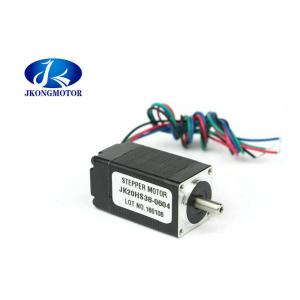180g.Cm Torque Nema 8 Stepper Motor , 20*20*30mm 0.6A 4-wire Micro Stepper Motor
Hybrid stepper motor is a combination of variable reluctance and permanent magnet motor. The stator is electromagnetically stimulated like variable reluctance stepper motor, and the rotor of the stepper motor is axially magnetized like permanent magnet stepper motor. This stepper motor is an actuator that converts electrical pulses into angular displacement.
All motors convert electrical power, volts and amps, into mechanical power, torque and speed. The unique feature of stepper motors is that they can be very accurately controlled in terms of speed and rotation angle. Stepper motors are brushless DC motors, and as such, require an electronic driver to commutate the windings. In order to control the rotation, electrical pulses are input into the driver, and the motor rotates one step for each pulse. The excellent stability of the motor results in a simple control circuit, since the motor can be run open-loop and no feedback is required.
1. Genaral Specification:
- Step Angle : 1.8°
- Step Angle Accuracy : ±5%(full step,no load)
- Resistance Accuracy : ±10%
- Inductance Accuracy : ±20%
- Temperature Rise : 80℃max
- Ambient Temperature : -20℃~+50℃
- Insulation Resistance : 100 MΩ Min. ,500VDC
- Dielectric Strength : 500VAC for 1minute
- Shaft Radial Play : 0.02Max. (450g-load)
- Shaft Axial Play : 0.08Max. (450g-load)
- Max. radial force : 28N (20mm from the flange)
- Max. axial force : 10N
2. Electrical Specification:
| Model No. | Step Angle | Motor Length | Current /Phase | Resistance /Phase | Inductance /Phase | Holding Torque | # of Leads | Motor Weight |
| | ( °) | (L)mm | A | Ω | mH | g.cm | No. | Kg |
| JK20HS30-0604 | 1.8 | 30 | 0.6 | 6.5 | 1.7 | 180 | 4 | 0.06 |
3. Drawing:




Stepper Motor Advantages
- Low cost for control achieved
- High torque at startup and low speeds
- Ruggedness
- Simplicity of construction
- Can operate in an open loop control system
- Low maintenance
- Less likely to stall or slip
- Will work in any environment
- Can be used in robotics in a wide scale.
- High reliability
- The rotation angle of the motor is proportional to the input pulse.
- The motor has full torque at standstill (if the windings are energized)
- Precise positioning and repeatability of movement since good stepper motors have an accuracy of 3–5% of a step and this error is non-cumulative from one step to the next.
- Excellent response to starting/stopping/reversing.
- Very reliable since there are no contact brushes in the motor. Therefore, the life of the motor is simply dependent on the life of the bearing.
- The motors response to digital input pulses provides open-loop control, making the motor simpler and less costly to control.
- It is possible to achieve very low-speed synchronous rotation with a load that is directly coupled to the shaft.
- A wide range of rotational speeds can be realized as the speed is proportional to the frequency of the input pulses.




